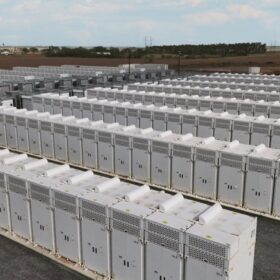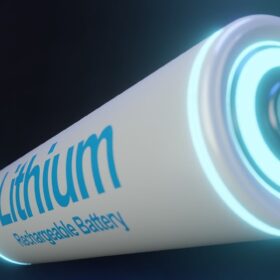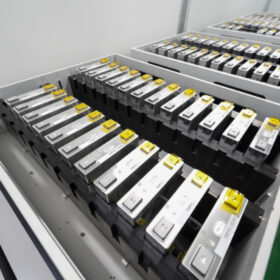Solar industry icon: ‘This group of people is not going to be thwarted’
Dick Swanson has left his fingerprints all over the modern solar industry. He is widely known for spreading the word on solar’s impressive learning curve with what has become known as Swanson’s Law, for developing the interdigitated back contact (IBC) cell, and for founding SunPower. In June, Swanson was named 2025 IEEE Photonics Society Aron Kressel Award Recipient and spoke with pv magazine to reflect on his work.
Tariff uncertainty grips U.S. battery development
The Trump administration’s China tariffs have piled atop existing and developing trade barriers on battery energy storage systems, components, and materials – destabilizing the U.S. energy storage industry. While existing inventories will allow project development to move forward in the short term, uncertainty extends across the supply chain, including to prospective manufacturers.
Solar manufacturing moving onshore and prospering
Efforts to establish solar manufacturing in the United States, on the back of generous Inflation Reduction Act subsidies, have had mixed results. While module assembly facilities appeared swiftly, cell production capacity trails far behind and current policy uncertainty is leaving more questions than answers for solar manufacturers of all sizes.
A 920% tariff on anode materials from China “would throw the economics of U.S. storage out of whack”
Battery installations in the U.S. are threatened by the imposition of anti-dumping, countervailing duties on active anode materials. The supply chain for Active Anode Materials (AAM) is dominated by Chinese producers, with attempts to establish the full supply chain outside of China years away.
S&P Global: Annual battery cell production passes 10 billion, lower prices to stimulate demand
While oversupply remains a feature of the lithium-ion battery production landscape, large production volumes are accelerating innovation and enhancing energy storage competitiveness. S&P Global analysis reveals that balance is likely to return to the global market in the coming years as stationary energy storage and EV adoption continues to accelerate.
BloombergNEF: Stationary storage installations surge to 170 GWh in 2024
With expanding market opportunities and declining costs stationary battery energy storage installations are surging. Battery makers are awake to the opportunity, reports BloombergNEF, as stationary batteries account for an increasing amount of deployed capacity.
How will PV’s intellectual-property scuffles shake out?
Lawyers are doing brisk business as tunnel oxide passivated contact (TOPCon) solar technology moves into the mainstream. A series of patent infringement cases have been launched in the United States and Europe and their impacts are reverberating through the marketplace. How likely is it that winners will emerge?
Bigger is better as module makers power ahead
Larger wafer and module sizes have had a profound influence on module power output in recent years but standardization appears to have taken hold, with no further increases evident in module data, according to Molly Morgan, a senior research analyst at Exawatt, which is now part of the CRU Group.
pv magazine interview: ‘In the next year, some of these guys are going to be bankrupt’
At Intersolar in Munich, pv magazine spoke with Jenny Chase, solar analyst at BloombergNEF, about the incredibly low polysilicon prices, massive overcapacity, and increasing consolidation. According to Chase, this year there will be enough polysilicon capacity to produce 1.1 TW of solar modules, but global module demand is expected to reach around 585 GW. “That is a pretty huge delta,” she said, noting that the solar industry should also prepare for a series of “negative feedback mechanisms,” such as negative prices and excess of solar power.
Shedding light on tandem perovskite solar cell progress
Perovskite tandem devices are at the front of the queue for commercialization but their characterization presents technical challenges.
















